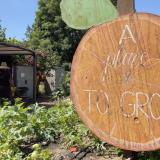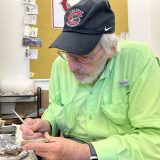Excitements and Disappointments: The chance to present in Turkey on my algal bloom research
October 15, 2016

Joselyn Aceves poses with her diploma cover and in her cap and gown at her graduation from Chapman in May 2016.
Just one year ago, I couldn’t have imagined the roller-coaster research on algal blooms would take me on.
My name is Joselyn Aceves, and I am a recent Chapman graduate. I graduated this past May 2016 with a B.S. in Biological Sciences and minor in Environmental Sciences. This whole idea of studying harmful algal blooms along the coast of California began in the fall of my senior year in Dr. Ramesh Singh’s three-hour-long Earth System Science class.
I remember sitting down with Dr. Singh and talking about what part of the earth system I would like to research in my term paper. I was totally stuck. Dr. Singh then asked what my interests are, and I told him that I plan on becoming a veterinarian because animal life and health are very interesting to me- specifically aquatic life.
With that Dr. Singh quickly suggested harmful algal blooms, a topic I had studied in-depth in a marine biology course in high school.
We proceeded in carrying out detailed analysis of satellite and ground data at different locations along the California coast for the period 2008-2015. We looked at Cal Poly SLO, the piers at Goleta, Newport, Santa Monica, and Scripps, and the wharves at Monterey, Stearns and Santa Cruz.
Specifically, sea surface temperature and chlorophyll concentrations derived from satellite data were analyzed together with ground observations of nitrogen, phosphorus, domoic acids and harmful algal blooms. When observing the data it turned out that the frequency of harmful algal blooms were found to increase in recent years depending upon the enhancement of chlorophyll concentrations, the discharges along the coast, and dynamics of the sea surface temperature. The frequency of harmful algal blooms is higher in the northern California compared to southern California. Also, the anthropogenic activities along the coast have increased. Recent forest fires and long-range transport of dusts from Asia appear to also contribute. The aerosol optical depth derived from satellite data during summer months seems to play an important role in the frequency of harmful algal blooms, as well.
It was not until I had finished the earth system science course that Dr. Singh reached out to me and mentioned submitting my research paper, titled “Enhancement of Chlorophyll Concentration and Growing Harmful Algal Bloom Along the California Coast“, to a Committee on Space Research (COSPAR), COSPAR’s goal is to promote scientific research in space at an international level by sharing results, information, and opinions on the subject matter.
At first, I was hesitant to committing to this because it was my last semester at Chapman before graduating, and I was beyond busy with classes and club meetings. However, Dr. Singh convinced me and we submitted the abstract. To my surprise, I got an email later on stating that I had been accepted to present my paper orally at the COSPAR Conference in Turkey, Istanbul.
I was in shock and extremely happy because I had never been faced with such as great opportunity. Thus, after figuring out the financial part of attending I accepted. I was one step closer to presenting my research in a completely different country I had never visited.
With all the tumult in Europe, my family warned me it was probably not safe to travel there. Excited by this opportunity, I ignored them. However, when I was in Mexico visiting family later on, my uncle called me into the den and showed me the news announcing a terrorist bombing that had just happened in the Atatürk airport. That is the same airport I was going to be landing at in Turkey.
It was at that moment that I began to worry. I quickly reached out to Dr. Singh. After talking with him, I decided to just wait things out before completely ruling out the trip. But just 4 days before my departing flight, Dr. Singh and I both received an email from COSPAR: the conference was being cancelled due to the coup attempted by the Turkish Military.
Naturally, I was sad to see this opportunity dissolve. I was also slightly relieved. I had begun to feel uneasy about traveling in that part of the world after so many attacks have been reported. Nonetheless, I am grateful that COSPAR accepted my work for presentation, for Dr. Singh’s ongoing support throughout the process, and for Chapman’s financial supports even after this unforeseen cancellation.
I hope to one-day come across another experience like this, but for now I will be grateful for my acceptance in the conference.


